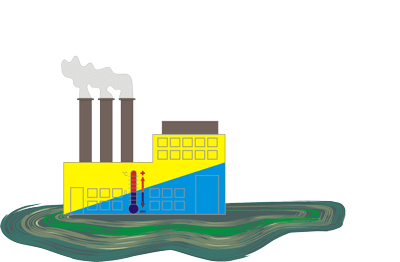Need the professional support?
Please contact our sales department.
When moist air is heated, its relative humidity decreases, while cooling leads to an increase in relative humidity, although in both cases the actual moisture content of the air does not change.
Only the ratio of the actual amount of water vapor in the air to the maximum amount corresponding to the state of saturation changes. Cooling the air to the level corresponding to 100% relative humidity causes the saturation conditions (the so-called dew point) to be reached and the steam condensation process to start. Under these conditions, the air can no longer hold the previous amount of water in a gaseous state and the water vapor condenses. The amount of condensed water corresponds to the difference of the maximum steam content in the air before and after cooling.
Relative humidity, the ratio of the concentration of water vapor contained in the air to the concentration that would saturate the air at a given temperature; it is expressed as a percentage. 100% relative humidity means the maximum saturation of the air with water vapor (and not the liquid state of water). A further increase in saturation is not possible because the water vapor begins to condense.
Dew point temperature or dew point – it is the temperature at which, given the composition of the gas or gas mixture and the set pressure, the process of liquefaction of the gas or the selected component of the gas mixture can begin.
In the case of water vapor in the air, it is the temperature at which the water vapor contained in the air becomes saturated (at the given composition and air pressure), and below this temperature it becomes supersaturated and condenses or resublimes.
| Air temperature [°C] | Relative air humidity [%] | Dew point temperature [°C] | Permissible temperature difference [°C] |
|---|---|---|---|
| 20 | 30 | 1.9 | <18.1 |
| 20 | 40 | 6.0 | <14.0 |
| 20 | 50 | 9.3 | <10.7 |
| 20 | 60 | 12.0 | <8.0 |
| 20 | 70 | 14.4 | <5.6 |
| 20 | 80 | 16.4 | <3.6 |
| 20 | 90 | 18.3 | <1.7 |
Water vapor condensation in the luminaires
The problem of water vapor condensation occurs in luminaires with a degree of protection above IP 54. High tightness and properties of the materials from which the housings are made have a limited ability to exchange heat with the environment.
Changing the work load of the luminaire /luminaire on and off/ is often the cause of water vapor condensation.
Luminaire ON

The temperature inside the luminaire is higher than the ambient temperature due to the heating of the electrical components of the luminaire.

The warm air inside the luminaire absorbs moisture that penetrates from the outside.
Luminaire OFF

The temperature inside the luminaire drops. The cooler air releases moisture, which condenses inside the luminaire.
Condensation of water vapor in internal installations

All facilities and installations with temperature differences and humidity, such as laundries, kitchens, etc.
Condensation of water vapor in outdoor installations

The main reason for condensation of water vapor in open areas are large temperature changes (day/night, weather change, intense insolation).
The higher the relative humidity of the air and the higher the temperature difference between the luminaire and the environment, the more probable is the condensation of water vapor in the luminaire.
Remontowa Lighting Technologies S.A. to prevent the occurrence of phenomena use special glands and breathing valves in their luminaires. In these devices, air enters the luminaire through special membranes impermeable to water vapor. As a consequence, the luminaire is dried by air exchange while maintaining tightness up to IP 67. On special customer’s request, we equip luminaires with appropriate protections. For order specifications, please contact the factory.
 Designers area
Designers area